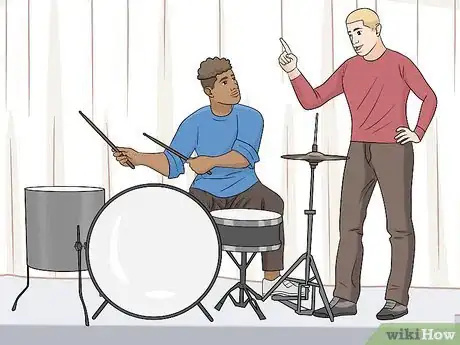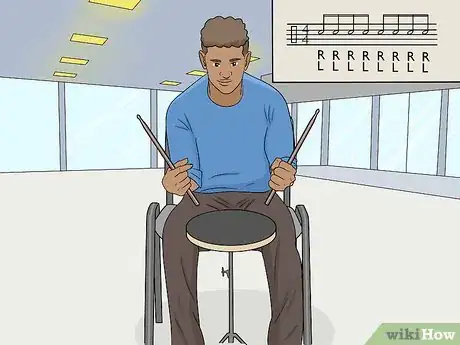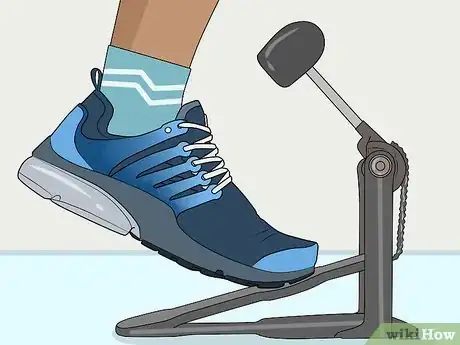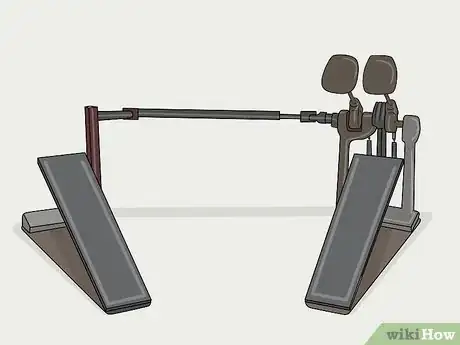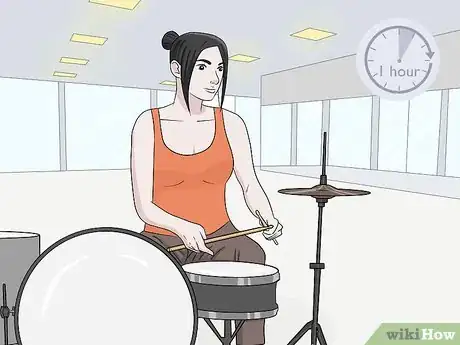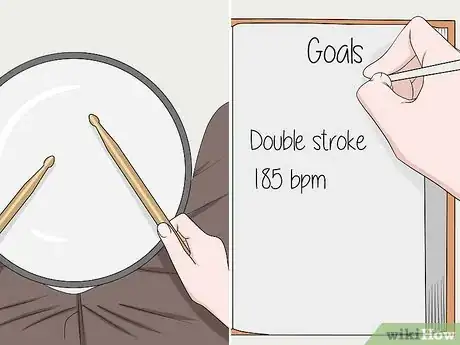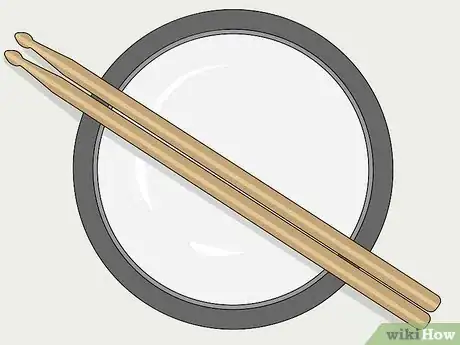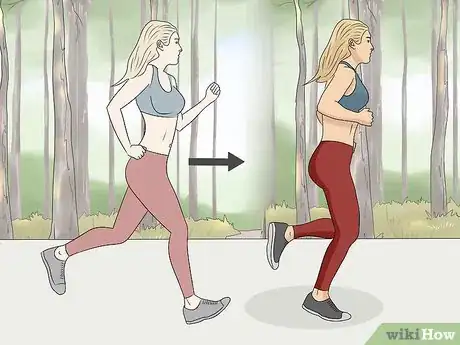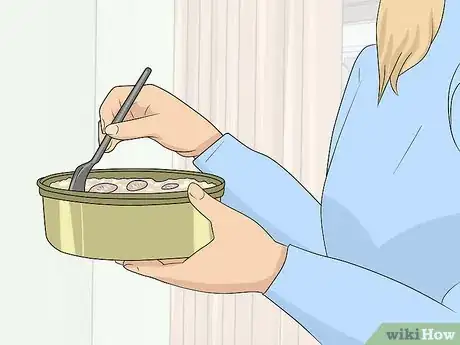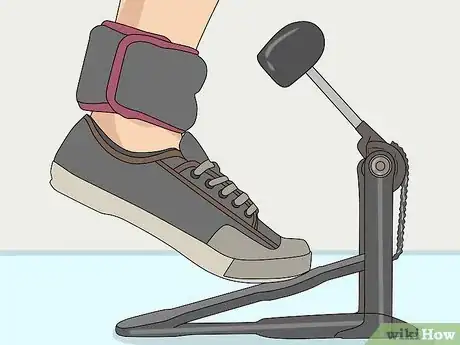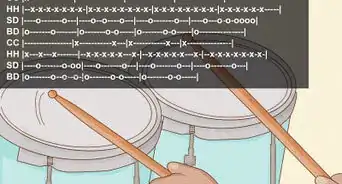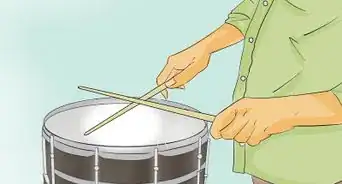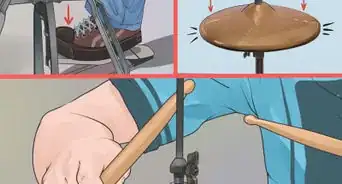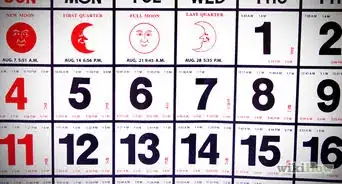This article was co-authored by wikiHow Staff. Our trained team of editors and researchers validate articles for accuracy and comprehensiveness. wikiHow's Content Management Team carefully monitors the work from our editorial staff to ensure that each article is backed by trusted research and meets our high quality standards.
There are 7 references cited in this article, which can be found at the bottom of the page.
This article has been viewed 39,996 times.
Learn more...
It’s easy to pick up a pair of drumsticks and start playing the drums, but it takes a lot of hard work, dedication, and practice to improve your drumming skills. In order to do so, start by mastering the basics and creating good practice habits. Don’t overlook your health, either! Drums are a physically demanding instrument, so you have to be in good shape to reach your full potential.
Steps
Mastering the Basics
-
1Take drumming lessons to learn the fundamentals. Find a local music school or drum teacher and sign up for classes to learn the basics. They will be able to teach you the fundamentals and provide you with some starting structure.
- If you can’t afford drum lessons or there aren’t any available in your area, then you can also find lots of video courses and lessons online for free or much cheaper than in-person lessons.
-
2Learn how to read drum tabs so you can play on your own. Memorize the notes and symbols that correspond to the pieces of your drum kit. This will allow you to sit down and play a song on the drums just by looking at the sheet music.[1]
- You can learn how to read drum sheet music from your teacher or online. It’s more memorization than anything.
Tip: A good thing to remember is that the height of the note on the 5 lines of the sheet music roughly represents where it is in your drum kit. For instance, cymbals sit higher than your drums, so the notes for playing them are at the top of the 5 lines in drum sheet music.
Advertisement -
3Master the basic rudiments before you try to develop your own style. Practice and master basic drum rudiments like the single (RLRL LRLR) and double stroke rolls (RRLL LLRR). Other basic rudiments to work on are the paradiddle (LRLL RLRR) and five-stroke roll (2 double strokes and a single stroke).[2]
- Incorporate these into your practice routine, even if it feels monotonous, because perfecting your basics is key to helping you play more complex beats.
- The more you practice these basic rudiments, the more you will build them into your muscle memory so you’ll be able to play them without thinking.
-
4Practice playing with a metronome or other timekeeping machine. It is the drummer’s responsibility to keep the time of the songs that the band is playing. Use a metronome, drum machine, or click track while you practice to learn how to keep time.[3]
- You can also practice playing along to professionally recorded songs to make learning how to keep time more interesting. Pick some of your favorite band’s tracks and play along to them to practice playing in time with them.
-
5Work on strengthening your non-dominant hand. Your dominant hand is normally stronger than your other hand. Use your non-dominant hand to play louder notes and your dominant hand to play softer notes to strengthen your non-dominant hand.[4]
- Remember to relax your hands when you hold your sticks.
- Try flipping your sticks over and playing with the fat ends to play harder, or try using brushes to play softer melodies. This will help your hands and wrists develop to play different styles of music at different volumes and intensities.
- You can also use special sticks that are heavier than normal when you practice to work on developing and strengthening your hands.
-
6Practice the heel-toe technique to increase your bass drum speed. Raise your heel up from the bass pedal, then throw it down as hard as you can, which will automatically make your toes play a second note. This lets you play fast complex bass drum patterns, such as double stroke rolls, with ease.[5]
- Practice this technique slowly at first to build it into your muscle memory, then gradually speed it up. Practice it separately with both your right foot and left foot.
-
7Use 2 bass drum pedals to play more complicated beats. Do this with either 2 pedals on 1 drum, or 2 pedals and 2 bass drums. This is another technique that will allow you to play more complex, faster patterns that are fairly difficult with a single pedal.[6]
- Imagine how much harder playing drums would be with just 1 hand. This is how much easier playing complicated bass patterns will be when you can use both feet at the same time.
- You can use 2 bass pedals with the heel-toe technique to play extremely fast and complicated beats.
Creating Good Practice Habits
-
1Set aside at least 1 hour of focused, solo practice time every day. Differentiate between your solo practice sessions and jam sessions. Focus on properly using techniques and on quality rather than quantity in your practice sessions.[7]
- One hour of focused, disciplined, quality practice is better than 4 hours of aimless jamming. It allows you to work on and improve your techniques and practice the rudiments. A jam session, on the other hand, is an opportunity for you to apply the techniques that you have been working on in your practice sessions.
- Many drummers allocate a lot of time to jamming sessions, but hardly reserve time for focused solo practice sessions. Schedule different times for practice and for jamming to help you concentrate on developing your independent style, manage your speed, and have better control of your feet and sticks.
-
2Set achievable goals for each practice session and keep track of them. Keep a progress journal of your practice sessions and log your goals in it. This will help you keep track of your problem areas and help you move from practicing what you already know to trying out different routines.[8]
- For example, you could set a goal of playing rudiments at different tempos. In 1 practice session you could play a double stroke roll at 185 bpm, and in another at 180 bpm.
- Your goals can be very simple and don’t have to be hard. The important thing is that you have a purpose and focus on practicing specific things in each session so you keep improving every time.
-
3Play on a practice pad to develop better stick control. It’s easy to get distracted when you have a complete drum kit in front of you, so a practice pad forces you to focus completely on your stick control. Practice on a pad about half the time to really develop your stick control, speed, and technique.[9]
- If you don’t have a practice pad, you can use a pillow instead. There is virtually no bounce on a pillow, so it forces you to work even harder and bring the sticks back up with your wrists.
Tip: With just a pair of sticks, a practice pad, and a metronome, you can greatly improve your drumming skills. You can also take these things with you in a backpack to practice just about anywhere!
-
4Play with other musicians and ask them to give you feedback. You don’t have to be in a band to play with other musicians. Ask any musician friends you have to come jam with you, or just listen to you play and give you feedback.[10]
- This is of great importance when you want to go from being a good drummer to a great drummer. Other musicians will give you invaluable tips and feedback that can help you improve and work on your personal style.
- Make sure to discuss ideas and get creative when you play with other musicians. This will allow you to discover and learn new drumming sounds and styles and develop your individual style.
- You can also just watch and listen to other drummers play to see how they execute certain techniques.
Improving Your Drumming Fitness
-
1Do cardio training exercises to increase your stamina. Go running, swimming, or cycling to improve your endurance for those long drumming sessions. Studies have shown that 90 minutes of intense drumming requires the same stamina as playing a professional soccer game.
- Getting in shape will let you play longer and harder, as well as help protect your body from injuries due to excessive playing.
Tip: Climbing (such as at an indoor bouldering gym) is a fun alternative exercise that will help you strengthen your hands and wrists as well as improve your balance, which are all essential to drumming.
-
2Lift weights to improve your power and reflexes. Weight training will help you get stronger, which lets you play the drums harder. It will also improve your overall coordination and help prevent muscle strain.
- Always warm up and stretch before lifting weights, as well as before playing the drums. This will get your blood flowing and help keep your joints and muscles from getting strained.
- Abdominal and back exercises will help strengthen your core, which is a main support area of your body for drumming. Squats and calf raises will help strengthen your ankles, knees, and hips, which will help you execute bass drumming techniques.
-
3Eat a healthy, balanced diet to increase your energy levels. Avoid eating a lot of fatty, sugary, salty, or processed foods. Eating a balanced diet will help you recover faster after playing the drums, as well as give you more energy and stamina while you play.
- High-protein foods like chicken, fish, and eggs, as well as healthy fats like avocados, nuts, and olive oil are good things to include in your drummer’s diet. Don’t forget to eat lots of fruits and vegetables as well, and stay hydrated with water!
-
4Use ankle weights to develop bass drumming speed and control. Wear ankle weights for at least 20 minutes during practice. Practice things like the heel-toe technique and using 2 pedals at once to increase your speed and control with various bass drumming techniques.[11]
- When you remove the ankle weights, you will feel like your feet are floating and you will be much more relaxed and at-ease on the pedals.
Community Q&A
-
QuestionI want to be a better drum player, I have received a lot of insults due to my drumming skills. Advice?
 TubularculiosisCommunity AnswerUltimately, it’s a matter of continuing to practice and persevere towards become better at the drums. Don’t let the insults drag you down, just keep pushing forward and practicing the drums, that’s the only way you’ll improve.
TubularculiosisCommunity AnswerUltimately, it’s a matter of continuing to practice and persevere towards become better at the drums. Don’t let the insults drag you down, just keep pushing forward and practicing the drums, that’s the only way you’ll improve.
References
- ↑ https://www.kickstartyourdrumming.com/drum-sheet-music/
- ↑ https://www.kickstartyourdrumming.com/how-to-become-a-better-drummer/
- ↑ https://www.freedrumlessons.com/articles/practice-tips.php
- ↑ https://takelessons.com/blog/8-ways-to-be-a-better-drummer-z07
- ↑ https://drummagazine.com/increase-bass-drum-speed/
- ↑ http://www.rockdrummingsystem.com/underground/drum-articles/bass-drum-speed-power-control.php
- ↑ https://www.freedrumlessons.com/articles/practice-tips.php
- ↑ https://www.freedrumlessons.com/articles/practice-tips.php
- ↑ https://www.freedrumlessons.com/articles/practice-tips.php
